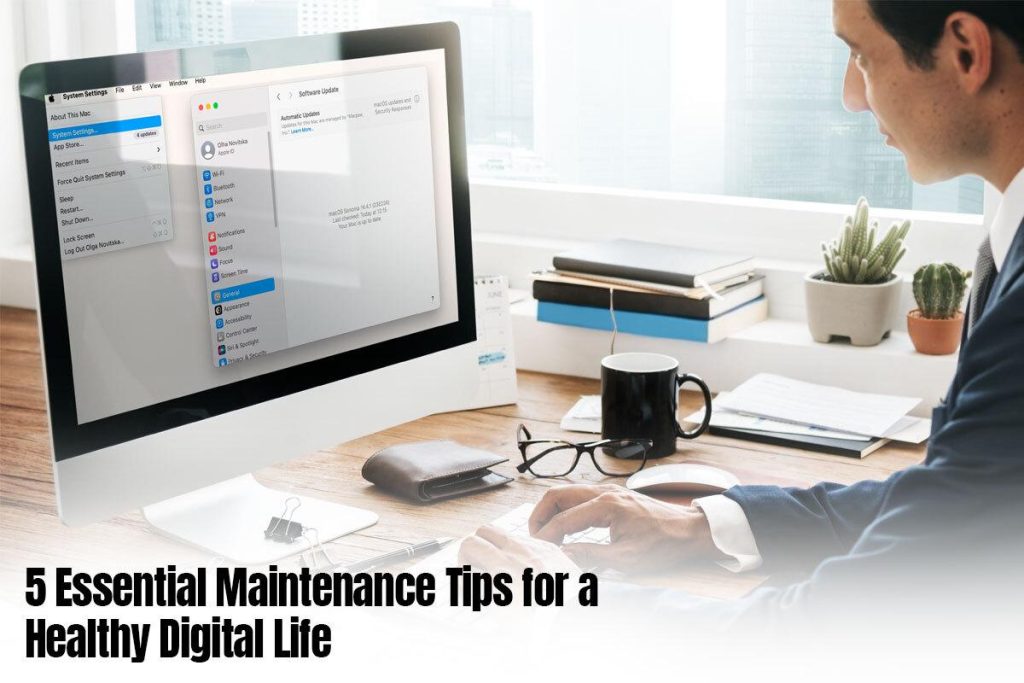In today’s tech-centric world, maintaining a balanced digital life is paramount. With screens surrounding us for work, leisure, and social connection, it’s easy to become overwhelmed or even experience digital burnout. A healthy digital life isn’t just about limiting screen time; it’s about setting up sustainable habits and routines that allow you to use technology effectively without compromising mental, physical, or emotional well-being.
Here are five essential maintenance tips to help you create a balanced, healthy digital lifestyle.
Regularly Declutter
Just as a cluttered physical environment can lead to stress, a cluttered digital space can affect productivity and peace of mind. Organize your files, delete redundant items, and keep your digital workspace as clean as your physical one. Not only does this make it easier to find what you need, but it also helps your device run more smoothly.
- Maintain a folder system: Create an organized folder system for documents, images, and media. Arrange files by category, date, or purpose, and make it a habit to review and delete old or duplicate files regularly.
- Clear out applications: Periodically check your installed apps and delete those you no longer use. Unnecessary apps consume storage and can slow down your device over time.
- Clear the cache: Clearing out cached data helps maintain a device’s speed and frees up storage. For instance, regularly clearing the YouTube cache on your Mac can improve browser performance and ensure smooth streaming. Here’s a useful guide on how to clear the YouTube cache on Mac.
Limit Screen Time to prevent Digital Burnout
Without proper boundaries, digital life can become overwhelming, leading to issues like eye strain, fatigue, and sleep disturbances. Taking control of your tech usage with specific boundaries can significantly improve your mental and physical well-being.
- Schedule tech-free time: Designate specific times during the day to disconnect from your devices. For example, make it a rule to avoid screens during meals and an hour before bed.
- Practice the 20-20-20 rule: Prolonged screen time can lead to eye strain, also known as digital eye strain. To prevent it, follow the 20-20-20 rule: every 20 minutes, look at something 20 feet away for at least 20 seconds. This simple exercise helps reduce eye strain and keeps your eyes healthy.
- Use digital well-being apps: Many apps, like Apple’s Screen Time or Google’s Digital Wellbeing, allow you to monitor and control your screen time. Set app usage limits and daily goals to keep your digital habits in check.
Give importance to Cybersecurity measures
A healthy digital life includes staying safe from online threats like viruses, phishing attacks, and data theft. Cybersecurity isn’t just for IT experts – every digital user can implement basic measures to protect themselves and their data.
- Use robust, unique passwords: Avoid using the same password across multiple sites, and choose combinations that include letters, numbers, and special characters. Consider using a reputable password manager to keep track of your passwords securely.
- Turn on 2FA: Many apps and websites offer two-factor authentication as an extra security measure. With 2FA, you’ll need to verify your identity with a secondary device, such as your phone, to access your accounts.
Organize the Digital Communication Channels
Staying connected is important, but managing multiple communication channels can be draining if left unchecked. Whether it’s emails, social media, or messaging apps, organizing and streamlining your digital communication can reduce stress and improve focus.
- Unsubscribe from unwanted emails: Take a few minutes to unsubscribe from newsletters and promotions that don’t add value. This will reduce inbox clutter and make it easier to spot important emails.
- Consolidate messaging apps: Many people use multiple messaging platforms (e.g., WhatsApp, Messenger, Slack), which can be overwhelming. Try to consolidate your communication channels to the essentials and set boundaries around when you check them.
- Organize email with folders: Set up folders and labels in your email client to categorize messages by priority, project, or contact. This system keeps your inbox organized and helps you locate emails faster.
Restrain from sharing too much on Social Media
Do not share too much on social media channels. Have restraint!
Use the privacy settings wherever possible and set your social media profile to private. Avoid sharing your current location and personal information. Remember, some may use your data against you. Therefore, be careful.
Concluding Thoughts
A healthy digital life is about creating sustainable habits that make your tech experience safer, more efficient, and less stressful. By decluttering regularly, setting boundaries, securing your data, organizing communication, and practicing restraint with your data on social media, you’ll be well on your way to a balanced, productive digital lifestyle. These tips are easy to include into your daily routine and can have a considerable impact on your digital well-being and overall quality of life. Best of luck!
